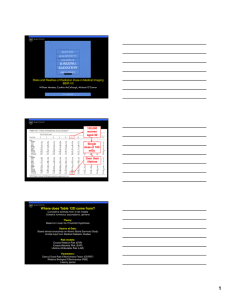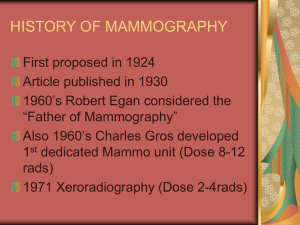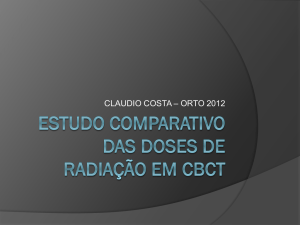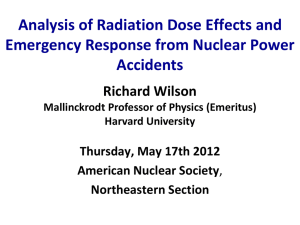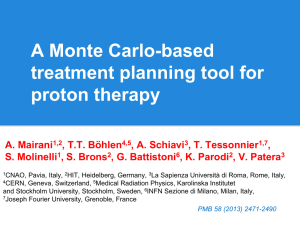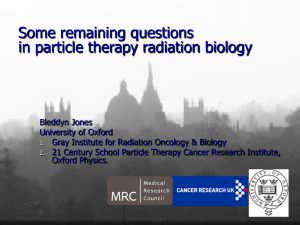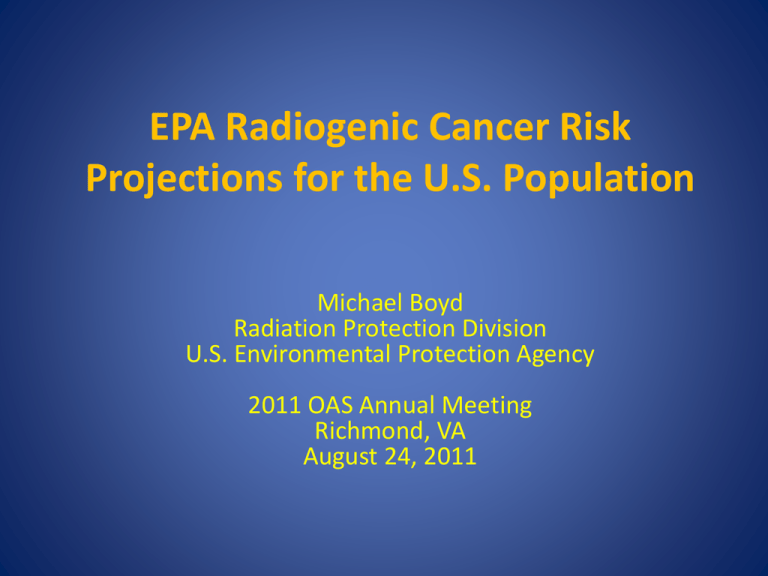
EPA Radiogenic Cancer Risk
Projections for the U.S. Population
Michael Boyd
Radiation Protection Division
U.S. Environmental Protection Agency
2011 OAS Annual Meeting
Richmond, VA
August 24, 2011
EPA’s Risk Estimates
• Old “Blue Book” published (1994)
• Addendum on uncertainties with some
revisions (1999)
• FGR-13: radionuclide specific estimates (1999)
2
NAS BEIR VII Rept. (2006)
•
Co-sponsored by EPA and several other Federal
agencies
•
Developed models for estimating low dose, low-LET
radiogenic cancer risk as a function of:
–
–
–
–
–
•
Dose
Cancer site
Sex
Age-at-exposure
Age-at-diagnosis (death)
Developed quantitative uncertainty distributions
3
BEIR VII Treatment of Low Dose Issue
Endorsed LNT: “…the balance of evidence from
epidemiologic, animal and mechanistic studies tend
to favor a simple proportionate relationship at low
doses between radiation dose and cancer risk.”
Derived a DDREF of 1.5 for solid cancers based on a
“Bayesian” analysis of epidemiological and
radiobiological data
4
BEIR VII Risk Models
• Most models derived from Japanese Life Span Study
(LSS) incidence data
• Breast and thyroid risks from pooled analyses of
medical and LSS cohorts
• Most solid cancer risk models were assumed to have
the same age and temporal dependency
• Two models for most solid cancers, EAR and ERR:
– The excess absolute risk (EAR) adds to the
baseline cancer incidence or mortality rate
– The excess relative risk (ERR) multiplies the
baseline cancer rate
5
Cancer Risk Coefficients
• Excess absolute risk (EAR): rate of radiogenic
cancers per unit dose
• Excess relative risk (ERR): fractional increase
in cancer rate per unit dose; i.e., radiogenic
cancer rate per unit dose divided by baseline
rate in the population
6
EPA Modifications and Additions to
BEIR VII Approach
• Additional cancer sites (bone, kidney, skin)
• High-LET (α-particle) risk estimates
• Stationary population
• Weighted arithmetic mean of ERR & EAR
estimates rather than geometric mean
• Breast cancer analysis
• Risk estimate for prenatal exposures
• Expanded uncertainty analysis
7
Risk (Gy-1) from Uniform,
Whole-Body Irradiation
INCIDENCE
2011
1999
MORTALITY
2011
1999
MALES
9.6x10-2
6.5x10-2
4.7x10-2
4.6x10-2
FEMALES
1.4x10-1
1.0x10-1
6.9x10-2
6.8x10-2
ALL
1.2x10-1
8.5x10-2
5.8x10-2
5.7x10-2
8
Age-Dependence of Risk from
Whole-Body Irradiation
LAR per Gy
0.4
0.3
Incidence ——
Mortality – – – –
Incidence ———
Mortality ———
0.2
0.1
0
0
20
40
60
80
Age at exposure
9
Life-Table Calculations
Age- and Sex-Specific Survival Functions
•
•
•
•
•
Life-table calculation: corrects for competing causes of death
Survival function, S(a,ae): probability of surviving to age a,
conditioned on being alive at age of exposure, ae
r(a,ae) = f(D) g[a,ae,r0(a)] S(a,ae)
Lifetime Attributable Risk
due to an exposure at age ae:
LAR (ae) = ∑ r(a,ae)
Population risk:
∑ N(ae) LAR (ae)
10
Stationary Population
• Age distribution constant
– # births = # deaths, each year
– N(a) = N0 S(0,a)
• Risk per Gy for (small) acute exposure =
that for chronic low dose rate exposure
• Stationary population “older” than the U.S.
population ===> estimated radiogenic cancer
risk is lower
11
Averaging Model Projections
•
Weighted Arithmetic Mean
AM = w(EAR) + (1-w)(ERR)
•
Weighted Geometric Mean
log GM = w log (EAR) + (1-w) log (ERR)
• GM ≤ AM
• For most sites, BEIR recommended GM and w = 0.3,
GM = (EAR).3 (ERR).7
Exceptions – Lung (wts. reversed), Thyroid, Breast
12
LAR Projections for Incidence (x10-4 Gy-1)
Cancer Site
Males
Females
Sex-Averaged
Stomach
62
75
68
Colon
146
92
119
Lung
130
308
220
Breast
—
289
146
Leukemia
92
69
80
Other
525
518
522
(Skin)
(182)
(96)
(138)
Total
955
1351
1155
13
Other Revisions & Extensions to BEIR VII
• Thyroid: Model primarily based on NCRP Thyroid
Report (NCRP No. 159)
• Skin: Model projection for BCC but not included in
total incidence estimate
• Alpha-particles
– For most sites, RBE=20
– For leukemia, RBE=2
• Bone cancer
– Model based on studies of patients injected with 224Ra
– Low-LET estimate derived assuming that RBE=20
14
Major Sources of Uncertainty
• Sampling errors
• Transport of risk from the LSS cohort to
the U.S. population
• DDREF
• Age/temporal dependence
15
Uncertainty in Low-Dose “Extrapolation”
BEIR VII/EPA implicitly assumes:
(1) LQ dose-response:
R = α D + β D2
(2) β/ α, DDREF same for all solid cancers
95% CI on DDREF then turns out to be ≈ a factor
of 2, up or down
16
Uncertainties
Projection
(per 104 person-Gy)
Uncertainty Interval
(90%)
Stomach
68
(9, 220)
Colon
119
(42, 220)
Liver
30
(6, 94)
Lung
220
(83, 420)
Breast
146
(70, 290)
Prostate
44
(0, 200)
Thyroid
44
(15, 140)
Leukemia
80
(29, 160)
1180
(560, 2130)
Cancer Site
Total
17
Other Data Pertaining to Low Dose Risks
I. Radiobiology
• Experiments indicate novel phenomena not
easily reconciled with standard paradigm for
radiation carcinogenesis
– Adaptive response, bystander effect, genomic
instability, etc.
– Mostly based on cellular studies, inconsistency
among laboratories – significance for human
carcinogenesis unclear
– May produce increased as well as decreased risks
18
Other Data Pertaining to Low Dose Risks
II. Epidemiology
• Epidemiological data on cohorts receiving
fractionated or chronic exposures show excess risks,
generally consistent with a DDREF of about 1.
– Fractionated:
Multiple fluoroscopies (breast cancer)
Scoliosis patients (breast cancer)
Tinea capitis patients (thyroid)
– Chronic:
British nuclear workers (leukemia, solid cancers)
Chernobyl liquidators (leukemia)
Techa R. Cohort (leukemia, solid cancers)
Taiwanese apartment dwellers (leukemia)
Semipalatinsk test-site residents (solid cancers)
19
Future Plans
•
New “Blue Book”: Available on RPD web-site at
www.epa.gov/radiation
•
Addendum on RBE for low energy electrons and
photons to be published by ORNL
– Important for 3H betas, medical X-rays, & perhaps
certain external radionuclide exposure situations
– NCRP committee also working on such a report
•
New Federal Guidance Report on risks from external
and internal radionuclide exposures
– Replace FGR-13
– Use new risk models in combination with latest
ICRP dosimetry
20

